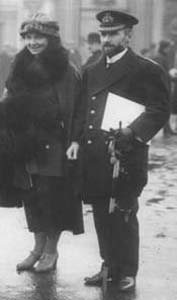Captain Walter Hugh Charles Samuel Thring

By Ross Lamont
Walter Hugh Charles Samuel Thring (1873-1949), naval officer, was born on 30 May 1873 at Bradford, Wiltshire, England, son of Rev John Charles Thring, and his wife Lydia Eliza Dyer, née Meredith. In 1886 Thring entered HMS Britannia, passing out two years later as midshipman. After heading the examination lists, he served from 1893 as Gunnery Lieutenant in the Channel, Pacific and China Squadrons and the Mediterranean Fleet. He was promoted Commander in 1903, became Flag Commander to Admiral Lord Charles Beresford in 1908 and shared in the Admiral's eclipse in 1909. Thring's lines for Dumaresq's [q.v.] rate of change of bearing instrument were adopted by the RN's gunnery command. He chose early retirement in February 1911.
Next year the Australian Naval Board was looking for a gunnery expert as assistant to the First Naval Member, Rear Admiral (Sir) William Creswell [q.v.], and in December Thring accepted the appointment to the RAN. On 11 January 1913 at St Mary's Church, Kilburn, London, he married Dorothy Wooldridge and on the 28th they left England, their three children were born in Australia. Shortly after Thring's arrival in Melbourne the Naval Board required him to accompany the Second Naval Member and the Chief of the General Staff, Brigadier General JM Gordon, to northern Australia and Papua. Seeing the futility of such a mission without a strategy for the naval defence of Australia, Thring advocated an early form of forward defence against Japan. He proposed naval bases at Bynoe Harbour, Northern Territory, and at the south-eastern tip of New Guinea. He appreciated the necessity for an Australian naval staff, developed a system of naval intelligence and produced a comprehensive War Book which was completed only a few weeks before August 1914. His foresight meant that Australia entered World War I with a high degree of naval preparedness.
Insisting on the priority of eliminating German warships in the Pacific, Thring had successfully pressed the Naval Board to take precautionary steps on the eve of war; on 4 August he secured his Minister's support for a request to the Admiralty to change the war orders of the battlecruiser HMAS Australia. The result was the speedy appearance of Australian warships in Rabaul harbour. Frustrated by orders from London to seize Germany's Pacific possessions, Thring never understood or excused British disregard of the Australian Navy's wish to act with maximum strategic orthodoxy.
Acting Second Naval Member for three months from October 1914, Thring was promoted Captain and appointed Director of (Naval) Ordnance from January 1915. As Director of War Staff he became the genius of whatever wartime autonomy the Naval Board preserved. In the Navy Office AW Jose was required to analyse the history of the RAN's wartime operations. He and Thring prepared for Prime Minister WM Hughes the Navy's views on post-war naval policy in the Pacific.
The collection of Pacific naval intelligence continued and an expansion of naval censorship and counter-intelligence work led to conflicts with other surveillance organisations. In March 1918 the head of the Counter Espionage Bureau, (Sir) George Steward, complained that - according to Admiral Creswell [q.v.] - "practically the whole of the administrative work of the Commonwealth Navy had been and was being carried out by Captain Thring". Before Lord Jellicoe arrived in Australia, Thring's health broke down, but Jellicoe's reports reflected much of Thring's strategy.
Routine tasks were found for him in England and Australia until his appointment in early 1920 as Australia's Naval Liaison Officer with the Admiralty in London. In 1922 his wife died. Soon afterwards Thring was eased out of his post and he resigned from the RAN. He had been appointed CBE in 1920. Left with his young children, for a short time Thring farmed in Gloucestershire and then established a school at Leiston, Suffolk, in which village on 11 July 1927 he married a widow Syria Elmslie Pearson, née Horwood. Survived by his wife, and by two daughters and a son of his first marriage, he died on 17 January 1949 at Bristol.


